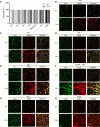Bacterial Adhesion and Biofilm Formation of Enterococcus faecalis on Zwitterionic Methylmethacrylat and Polysulfones
- PMID: 35651751
- PMCID: PMC9149206
- DOI: 10.3389/fcimb.2022.868338
Bacterial Adhesion and Biofilm Formation of Enterococcus faecalis on Zwitterionic Methylmethacrylat and Polysulfones
Abstract
Biofilm-associated implant infections represent a major challenge for healthcare systems around the world due to high patient burden and enormous costs incurred. Enterococcus faecalis (E. faecalis) is the most prevalent enterococcal species identified in biofilm-associated infections. The steadily growing areas of application of implants demand a solution for the control of bacterial infections. Therefore, the development of modified anti-microbial implant materials and the testing of the behavior of different relevant bacterial strains towards them display an indispensable task. Recently, we demonstrated an anti-microbial effect of zwitterionic modified silicone rubber (LSR) against Staphylococcus aureus. The aim of this study was to evaluate bacterial colonization and biofilm formation of another clinically relevant strain, E. faecalis, on this material in comparison to two of the most commonly used thermoplastic polyurethanes (TPUs) and other modified LSR surfaces. By generating growth curves, crystal violet, and fluorescence staining, as well as analyzing the expression of biofilm-associated genes, we demonstrated no anti-microbial activity of the investigated materials against E. faecalis. These results point to the fact that anti-microbial effects of novel implant materials do not always apply across the board to all bacterial strains.
Keywords: Enterococcus faecalis; biofilm; methylmethacrylat; polysulfone; zwitterion.
Copyright © 2022 Woitschach, Kloss, Schlodder, Borck, Grabow, Reisinger and Sombetzki.
Conflict of interest statement
Authors KS and AB are employed by Biotronik. The remaining authors declare that the research was conducted in the absence of any commercial or financial relationships that could be construed as a potential conflict of interest.
Figures




References
-
- Azari S., Zou L. (2013). Fouling Resistant Zwitterionic Surface Modification of Reverse Osmosis Membranes Using Amino Acid L-Cysteine. Desalination 324, 79–86. doi: 10.1016/j.desal.2013.06.005 - DOI
-
- Di Ciccio P., Vergara A., Festino A. R., Paludi D., Zanardi E., Ghidini S., et al. . (2015). Biofilm Formation by Staphylococcus Aureus on Food Contact Surfaces: Relationship With Temperature and Cell Surface Hydrophobicity. Food Control 50, 930–936. doi: 10.1016/j.foodcont.2014.10.048 - DOI
-
- Dunny G. M., Hancock L. E., Shankar N. (2014). Enterococci: From Commensals to Leading Causes of Drug Resistant Infection: Enterococcal Biofilm Structure and Role in Colonization and Disease (Boston: Massachusetts Eye and Ear Infirmary: ). - PubMed
-
- Fernández Guerrero M. L., Goyenechea A., Verdejo C., Roblas R. F., Górgolas M. (2007). De. Enterococcal Endocarditis on Native and Prosthetic Valves: A Review of Clinical and Prognostic Factors With Emphasis on Hospital-Acquired Infections as a Major Determinant of Outcome. Med. (Baltimore) 86, 363–377. doi: 10.1097/MD.0b013e31815d5386 - DOI - PubMed
Publication types
MeSH terms
Substances
LinkOut - more resources
Full Text Sources
Molecular Biology Databases

